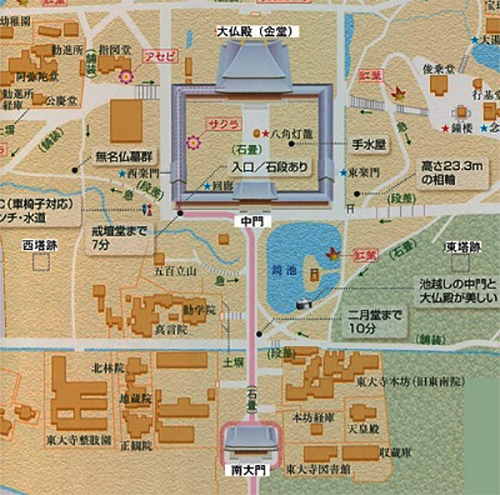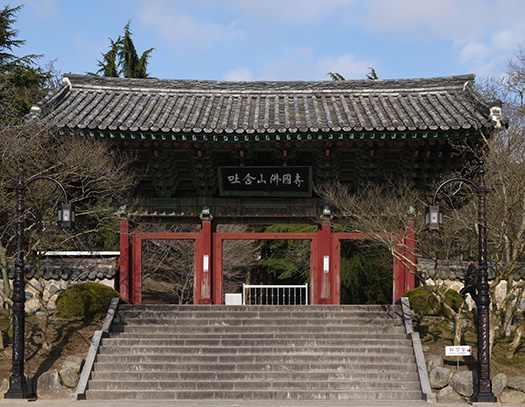

さてふたたび古建築再見シリーズ、今回は東大寺であります。
奈良には5−6回は行っているハズですが、必ず巡礼させていただいている。
であるのに伽藍配置がどうなっていたか、記憶が薄い。
最初にシカ達が迎えてくれて惑わされ宗教施設であることを忘れさせる(笑)。
この鹿は鹿島神宮の祭神・建御雷命が常陸国鹿島から白鹿に乗って移座したという
伝説に由来し、藤原氏の氏神である春日大社にも深く関わるとされる。
惑わされず今回の東大寺再見では鹿は無視し建築・計画にフォーカスしたい。



伽藍配置はWEBで発見すると2枚目の図の通り。
その下の地図は市街化している現状の状況であります。
現代われわれが見学・参詣しているのは南大門・中門・回廊・金堂(大仏殿)。
東西2つの塔は跡を見るだけで現存していない。
うかつにも伽藍配置をみてはじめて塔があったのだと知りました。
東大寺創建時期の様子は以下のよう。
7~8世紀の東洋世界は唐を中心に善隣友好の国際関係が昇華した時代。
唐朝は道教を信奉したが同時に仏教も振興し国家安寧と隆昌を祈願させた。
これらの政策がわが国でも古代国家の礎として導入された。
道教は中国の民間信仰であるのに対して仏教は世界宗教であり、
律令制度のような普遍性を持つことからいわば両輪として列島社会に導入された。
また、天然病などのパンデミックが猖獗したことで
鎮護国家思想が尊崇されて全国に刷り込まれていったと思われます。
741年聖武天皇はその息子が1歳に満たずに夭折したことから金鍾山寺を造営し、
やがて国分寺・国分尼寺建立の詔が発せられたのに伴い、
この寺が昇格して大和金光明寺となり、これが東大寺の前身寺院となった。
先日までみていた新羅・仏国寺創建が751年だったのでほぼ同時期。
写真としては上の東大寺南大門と対比させて仏国寺山門も下に掲載しました。
建築の規模としてははるかに東大寺南大門の大きさが際だっている。
内部に大好きな運慶による仁王像が安置されていることで知られます。
組物などの装飾性では過剰な仏国寺に比べて南大門はシンプル。
この時期、大仏開眼会に参列した新羅の使節団は同時進行建築として
この様子にどう反応して自国の仏国寺デザインに反映させたのか興味が湧く。
たぶん間違いなく建築の専門技術者も同行していたことが想定できる。
過剰なまでの組物の装飾性は対日関係での特色誇示の面も考えられる。
一方の東大寺、日本側はそういう対抗心は持たず、
むしろその後、唐から鑑真という仏教教義の最高級体現者自身を勧請し
唐招提寺を建立して、仏教本流の思想を列島社会に根付かせた。
なにやら模範的な仏教受容社会であったように思えます。
English version⬇
[Todaiji Nandaimon and the Garan "Awoniyoshi" Todaiji Revisited-1]
By the way, the old architecture review series again, this time is Todaiji Temple.
I have been to Nara 5-6 times, but I always make a pilgrimage.
However, I have little memory of what happened to the cathedral arrangement.
First, the deer welcomed me and made me forget that it was a religious facility (laughs).
This deer is said to have been transferred from Kashima, Hitachi Province, on a white deer by Takemikazuchi, the deity of Kashima Jingu.
Derived from a legend, it is said to be deeply involved in Kasuga Taisha, the deity of Mr. Fujiwara.
Without being confused, I would like to ignore deer and focus on architecture and planning in this review of Todaiji Temple.
The cathedral arrangement is as shown in the second figure when found on the WEB.
The map below it shows the current situation of urbanization.
Today, we are visiting and visiting the Namdaemun, Central Gate, Corridor, and Kondo (Great Buddha Hall).
The two towers, east and west, do not exist just by looking at the traces.
I knew that there was a tower for the first time when I saw the arrangement of the cathedral.
The state of the construction of Todaiji Temple is as follows.
The oriental world of the 7th and 8th centuries was an era when international relations of good neighbor friendship sublimated around Tang.
The Tang Dynasty worshiped Taoism, but at the same time promoted Buddhism and prayed for national well-being and Takamasa.
These policies were introduced in Japan as the foundation of the ancient nation.
Taoism is a Chinese folk religion, while Buddhism is a world religion.
It was introduced into the archipelago society as two wheels because it has universality like the Ritsuryo system.
In addition, due to the smallpox of pandemics such as natural diseases
It seems that the national idea of protection was revered and imprinted all over the country.
In 741, Emperor Shomu built Kinzokuji Temple because his son died before he was one year old.
Eventually, as the apology for the construction of Kokubunji Temple and Kokubunnanji Temple was issued,
This temple was promoted to Yamato Konkai-Komyoji, which became the predecessor of Todaiji.
The Silla Bulguksa Temple, which I had been watching until the other day, was built in 751, so it was about the same time.
As a photo, the Bulguksa Sanmon Gate is also shown below in contrast to the Todaiji Nandaimon Gate above.
The size of the Nandaimon Gate of Todaiji Temple stands out as the scale of the building.
It is known that the statue of Nio by his favorite Unkei is enshrined inside.
Namdaemun is simpler than Bulguksa Temple, which is overly decorative in terms of braids.
During this period, the Silla mission that attended the Great Buddha Opening Party was a simultaneous building.
I am curious about how it responded to this situation and reflected it in the design of Bulguksa Temple in my country.
It can be assumed that there was no doubt that a specialist in architecture was also accompanied.
Excessive decorativeness of the braid can be considered to show off its characteristics in relation to Japan.
On the other hand, Todaiji Temple and the Japanese side do not have such a rivalry,
Rather, after that, he solicited the highest-class manifestation of Buddhist doctrine called Jianzhen from Tang.
The Toshodaiji Temple was built and the mainstream Buddhist ideas took root in the archipelago society.
It seems that it was a model Buddhist receptive society.



















